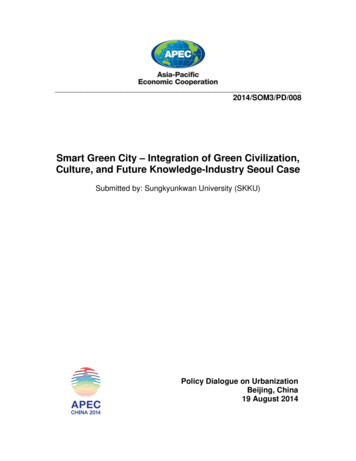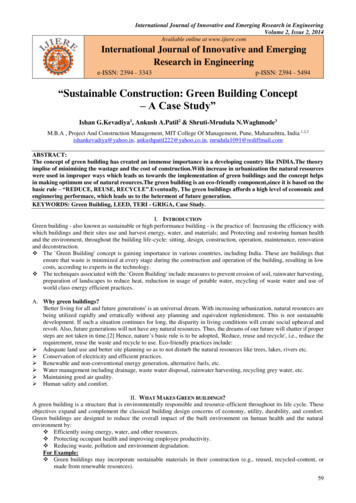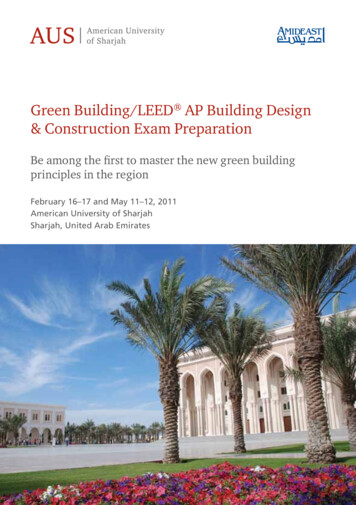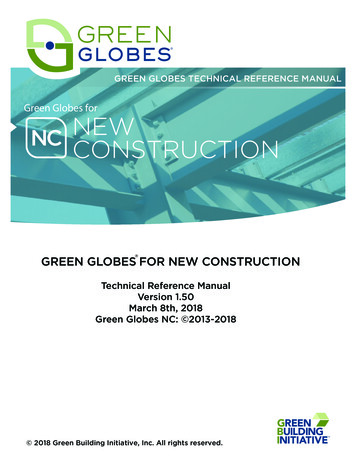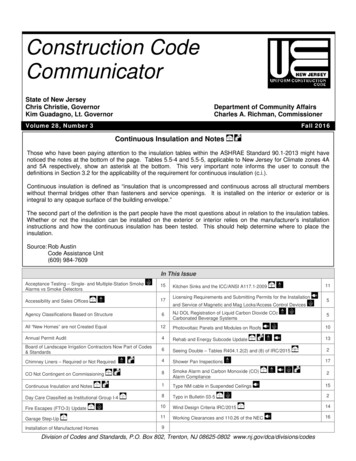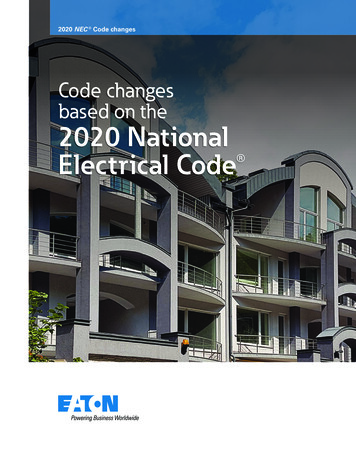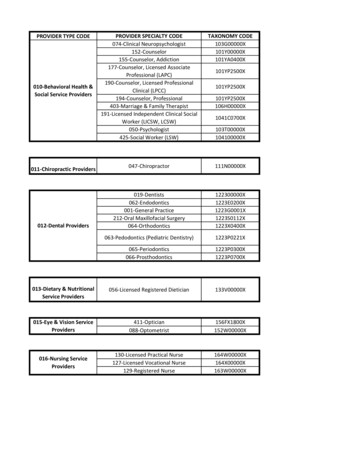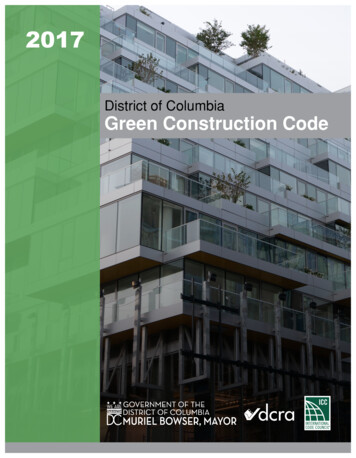
Transcription
2017District of ColumbiaGreen Construction Code
2017District of ColumbiaGreen Construction Code
2017 District of Columbia Green Construction CodeFirst Printing: September 2020COPYRIGHT 2012International Code Council, Inc. (for 2012 International Green Construction Code )COPYRIGHT 2020Government of the District of Columbia (for new text)ALL RIGHTS RESERVED. This 2017 District of Columbia Green Construction Code contains substantial copyrighted materialfrom the 2012 International Green Construction Code , 2nd printing, which is a copyrighted work owned by the InternationalCode Council, Inc. Without advance written permission from the copyright owner, no part of this book may be reproduced, distributed or transmitted in any form or by any means, including, without limitation, electronic, optical or mechanical means (byway of example and not limitation, photocopying or recording by or in an information storage retrieval system). For informationon permission to copy material exceeding fair use, please contact: Publications, 4051 Flossmoor Road, Country Club Hills, IL60478. Phone 1-888-ICC-SAFE (422-7233).This 2017 District of Columbia Green Construction Code also contains substantial copyrighted material from the District ofColumbia Construction Codes Supplement of 2013, Title 12 of the District of Columbia Municipal Regulations (DCMR), whichis a copyrighted work owned by the Government of the District of Columbia. A copy of the Supplement may be purchased fromthe Office of Documents, 441 4th Street NW, Suite 520 South, Washington, DC 20001, 202-727-5090. Title 12 of the DCMR isposted electronically at http://www.dcregs.dc.gov.Trademarks: “International Code Council,” the “International Code Council” logo, “ICC,” the “ICC” logo, “International GreenConstruction Code” “IgCC” and other names and trademarks appearing in this book are registered trademarks of the International Code Council, Inc., and/or its licensors (as applicable), and may not be used without permission.PRINTED IN THE USA
PREFACEBackgroundThe 2017 District of Columbia Construction Codes, effective May 29, 2020, consist of the following12 codes: 2017 District of Columbia Building Code [2015 edition of the International Building Code published by the International Code Council (ICC) as amended by the District of ColumbiaConstruction Codes Supplement of 2017 (DCMR 12A, Building Code Supplement)].1 2017 District of Columbia Residential Code [2015 edition of the International ResidentialCode published by the ICC as amended by the District of Columbia Construction CodesSupplement of 2017 (DCMR 12B, Residential Code Supplement)]. 2017 District of Columbia Electrical [2014 edition of the National Electrical Code publishedby the National Fire Protection Association (NFPA) as amended by the District of ColumbiaConstruction Codes Supplement of 2017 (DCMR 12C, Electrical Code Supplement)]. 2017 District of Columbia Fuel Gas Code [2015 edition of the International Fuel Gas Code published by the ICC as amended by the District of Columbia Construction Codes Supplement of 2017 (DCMR 12D, Fuel Gas Code Supplement)]. 2017 District of Columbia Mechanical Code [2015 edition of the International MechanicalCode published by the ICC as amended by the District of Columbia Construction CodesSupplement of 2017 (DCMR 12E, Mechanical Code Supplement)]. 2017 District of Columbia Plumbing Code [2015 edition of the International PlumbingCode published by the ICC as amended by the District of Columbia Construction CodesSupplement of 2017 (DCMR 12F, Plumbing Code Supplement)]. 2017 District of Columbia Property Maintenance Code [2015 edition of the InternationalProperty Maintenance Code published by the ICC as amended by the District of ColumbiaConstruction Codes Supplement of 2017 (DCMR 12G, Property Maintenance Code Supplement)]. 2017 District of Columbia Fire Code [2015 edition of the International Fire Code publishedby the ICC as amended by the District of Columbia Construction Codes Supplement of 2017(DCMR 12H, Fire Code Supplement)]. 2017 District of Columbia Energy Conservation Code [2013 edition of the Energy Standardfor Buildings Except Low-Rise Residential Buildings (ANSI/ASHRAE/IES 90.1-2013) published by ASHRAE (formerly known as the American Society of Heating, Refrigeration andAir-Conditioning Engineers, Inc.) and the 2015 edition of the International Energy Conservation Code —Residential Provisions published by the ICC as amended by the District ofColumbia Construction Codes Supplement of 2017 (DCMR 12I, Energy Conservation CodeSupplement)]. 2017 District of Columbia Existing Building Code [2015 edition of the International ExistingBuilding Code published by the ICC as amended by the District of Columbia ConstructionCodes Supplement of 2017 (DCMR 12J, Existing Building Code Supplement)]. 2017 District of Columbia Green Construction Code [2012 edition of the International GreenConstruction Code published by the ICC as amended by the District of Columbia Construction Codes Supplement of 2017 (DCMR 12K, Green Construction Code Supplement)]. 2017 District of Columbia Swimming Pool and Spa Code [2015 edition of the InternationalSwimming Pool and Spa Code published by the ICC as amended by the District of Columbia Construction Codes Supplement of 2017, 12 DCMR L, Swimming Pool and Spa Code Supplement)].1. The District of Columbia Municipal Regulations (DCMR) is the official compilation of rules and regulations issued by government agencies andthe Council and is available online at: http://dcregs.dc.gov/.2017 DISTRICT OF COLUMBIA GREEN CONSTRUCTION CODEiii
The ICC, ASHRAE and NFPA Codes have been extensively amended by the District of Columbia toaddress specific District of Columbia policies and statutes, and unique characteristics of the Districtof Columbia.The ICC and NFPA Codes provide a comprehensive, coordinated set of building safety and firecodes that have been adopted by 50 states and the District of Columbia at the jurisdictional or statelevel. The ICC’s consensus-based code development process involves a broad range of stakeholders,including construction industry representatives and code regulators, to ensure that the modelcodes incorporate the latest technical advancements, while addressing industry and regulatory concerns. The ICC Codes also provide helpful resources, such as interpretive commentary and history ofamendments, which provide a basis for interpreting the District of Columbia Construction Codes.In 1791, President George Washington issued the first building guidelines in Washington, DC.These guidelines largely emphasized aesthetics in order to ensure that new buildings complemented Pierre L’Enfant’s plan for the city. By 1872, during a period of rapid change and expansionafter the Civil War, the District of Columbia adopted the first comprehensive set of building regulations focusing on health and safety concerns. The 1872 regulations, introduced by the Congressionally established Board of Public Works, required building permits for the first time. Nineteenthcentury building regulation also included The Height of Buildings Act, enacted by Congress in 1899to address safety concerns about the use of steel framing. The greater building heights achieved bysteel-framed structures raised concerns about the city’s ability to extinguish fires, and the possibility of structural collapse.Consistent with the growing national trend towards nationally-recognized model building codes,in 1986 the District of Columbia adopted five of the 1984 codes published by the Building OfficialsCode Administrators (BOCA) International along with model codes published by the Council ofAmerican Building Officials and the National Fire Protection Association. In 1994, after BOCA combined with other model code groups to establish the ICC with a common goal of developing a singlecoordinated set of national model building codes, the District of Columbia began transitioning tothe ICC’s International Codes (I-Codes ). Beginning in 1999 the District of Columbia adopted the1996 International Mechanical Code and 1995 International Plumbing Code, and completed thetransition to the I-Codes in 2003, when nine of the 2000 edition of the I-Codes were adopted.Following the 2008 update of the District of Columbia Construction Codes, and in recognition ofthe need for a more robust, responsive and ongoing code development process in the District ofColumbia, a new Construction Codes Coordinating Board (CCCB) was created by Mayoral Order inMarch 2009 to replace the Building Code Advisory Committee.2 The members of the CCCB areappointed by the Mayor (except for one member appointed by the DC Council) and represent various stakeholders in the code development process, including architects, engineers, governmentregulators, representatives of the construction and housing industries and city residents. The CCCBis supported administratively by the District of Columbia Department of Consumer and RegulatoryAffairs (DCRA) and has been delegated authority by the Mayor to issue rules to amend the Construction Codes and to adopt the model codes pursuant to procedures set forth in the DC Official Code,§6-1409.In considering adoption of the ICC, ASHRAE and NFPA codes and reviewing local code change proposals, the CCCB considers relevant criteria and policies including: Minimum performance standards and requirements for construction and constructionmaterials, consistent with nationally accepted standards of engineering, fire, and lifesafety. Unique District of Columbia characteristics, policies or statutes. The use of modern technical methods, devices and improvements. Elimination of restrictive, obsolete, conflicting, duplicative, and unnecessary regulationsand requirements. Standards to make buildings and facilities accessible to and usable by physically disabledpersons.2. Mayor’s Order 2009-22 (February 25, 2009), as amended by Mayor’s Order 2012-32 (February 29, 2012).iv2017 DISTRICT OF COLUMBIA GREEN CONSTRUCTION CODE
Consideration of the 2012 I-Codes and the 2011 National Electrical Code began in October 2011at the direction of Mayor Vincent C. Gray who tasked the CCCB with meeting Mayor Gray’s statedgoal of making the District of Columbia the healthiest, greenest and most livable city in the UnitedStates. By adopting the 2012 International Green Construction Code and the 2012 InternationalEnergy Conservation Code as mandatory codes applicable to public and private sector buildings, theDistrict of Columbia has taken a national leadership role in establishing a regulatory framework forfostering green building practices.Development of the next update to the DC Construction Codes began in 2015 with a review ofthe 2015 I-Codes, 2013 ANSI/ASHRAE/IES 90.1-2013 and 2014 National Electrical Code. Initiated byMayor Muriel Bowser, the CCCB was tasked with simplifying the codes for both project teams andenforcement staff, while continuing to advance the District’s energy efficiency goals embodied inthe Sustainable DC plan.The Code Development ProcessAlthough administered by DCRA, the code development process reached well beyond the agency’scorridors. In addition to the Board members who met frequently, often weekly, over a four yearperiod, more than 100 individuals, including architects, engineers, contractors, property managers,real estate developers and government regulators, contributed countless hours attending technicaladvisory group meetings, as they pored over the model codes and developed code change amendments to reflect and incorporate local District of Columbia policies and concerns.This process resulted in more than 500 code change proposals, incorporated into the 2017 Districtof Columbia Construction Codes Supplement. Two rounds of public comment were sought through arulemaking process, consisting of a Notice of Proposed Rulemaking (65 DCR 40-Part 2, September 28,2018) and a Second Notice of Proposed Rulemaking (66 DCR 31-Part 2, July 26, 2019).Final recommendations were sent by DCRA to the Mayor and subsequently introduced to theDistrict of Columbia Council on January 30, 2020. The Codes were passively approved by the Councilon April 9, 2020 and became effective on May 29, 2020 when a Notice of Final Rulemaking was published in the DC Register (67 DCR 23-Part 2, May 29, 2020).Structure of the 2017 District of Columbia Construction CodesSince the District of Columbia Construction Codes consist of the ICC, ASHRAE and NFPA model codesas modified by the District of Columbia Construction Codes Supplement, the model codes and thelocal supplement must be consulted together to determine the complete text of the District ofColumbia Construction Codes. The I-Codes are available on the ICC’s website at http://publicecodes.cyberregs.com/icod. ASHRAE 90.1-2013 is available at -90-1-2013-si?gateway code ashrae&product id 1865967.The District of Columbia Construction Codes Supplement contains the local District of Columbiaamendments and modifications and is codified in Title 12 of the DCMR. Title 12 can be viewedonline on the website hosted by the Office of Documents and Administrative Issuances (ODAI):http://www.dcregs.dc.gov 3To assist the public, three of the District of Columbia Construction Codes may also be viewed inan integrated version, published by the ICC, which consolidates the respective ICC codes, ANSI/ASHRAE/IES 90.1-2013 and the District of Columbia amendments. The three integrated codes areavailable to the public through a link on the DCRA website, which enables online reading and limiteddownloading. These codes are as follows: 2017 District of Columbia Building Code 2017 District of Columbia Energy Conservation Code 2017 District of Columbia Green Construction Code3. Title 12 of the DCMR is also available on the DCRA website.2017 DISTRICT OF COLUMBIA GREEN CONSTRUCTION CODEv
The integrated version of the 2017 DC Green Construction Cod
2017 District of Columbia Energy Conservation Code [2013 edition of the Energy Standard for Buildings Except Low-Rise Residential Buildings (ANSI/ASHRAE/IES 90.1-2013) pub-lished by ASHRAE (formerly known as the American Society of Heating, Refrigeration and Air-Conditioning Engineers, Inc.) and the 2015 edition of the International Energy .
